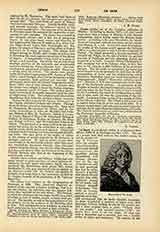

Lepanto, Italian name for NAUPACTOS (NAUPACTUS), a titular metropolitan see of ancient Epirus. The name Naupactus (dockyard) is said to have originated in the traditional building of a fleet there by the Heraclidae (Strabo, IX, iv, 7). The site must have been chosen on account of the strong position of the hill, the fertile plains of the neighborhood, and the many streams. Situated on the coast of Locris, it originally belonged to the Locri Ozolm but was subsequently taken by the Athenians, who in 455 B.C., after the Third Messenian War, established there the Messenian helots, the bitter enemies of Sparta (Pausanias, IV, xxv, 7; X, xxxviii, 10). After the battle of “Egospotami (404 B.C.), the Spartans captured Naupactus, drove out the Messenians, and restored the town to the Locri Ozolae. Subsequently, it passed in turn to the Achaeans, the Thebans, and to Philip of Macedon, who gave it to the 2Etolians; hence it was sometimes called the “City of the Aetolians” (Strabo, IX, iv, 7). For two months Naupactus fiercely resisted the Romans, who under M. Acilius Glabrio finally (191 B.C.) captured the town. Pausanias (X, xxxviii, 12-13) saw there near the sea a temple of Poseidon, another of Artemis, a cave dedicated to Aphrodite, and the ruins of a temple of Esculapius. During Justinian’s reign Naupactus was almost entirely destroyed by an earthquake (Procopius, “Bell. Goth.”, IV, xxv).
Le Quien (Oriens Christianus, II, 197-200) mentions only ten of its Greek bishops, the first of whom took part in the Council of Ephesus (431), but our manuscript lists contain ninety-eight names. The metropolitan See of Naupactus depended on the pope, as Western Patriarch, until 733, when Leo III the Isaurian annexed it to the Patriarchate of Constantinople. In the early years of the tenth century it had eight suffragan sees (Gelzer, “Ungedruckte. Texte der Notitiae episcopatuum”, Munich, 1900, p. 557); nine about 1175 under Emperor Manuel Comnenus (Parthey, “Hieroclis Synecdemus”, Berlin, 1866, p. 121), but only four at the close of the fifteenth century (Gelzer, op. cit., 635). Annexed to the Greek Orthodox Church in 1827, the see was suppressed in 1900, and replaced by the See of Acarnania and Naupactia, whose seat is at Missolonghi; the limits of this diocese are identical with those of the nome Aetolia and Acarnania. As to the Latin archbishops of Naupactus during the Frankish occupation, Le Quien (Oriens Christ., III, 995) and Eubel (Hierarchia catholica medii aevi, I, 379; II, 222) mention about twenty in the fourteenth and fifteenth centuries.
Occupied by the Turks in 1498, Lepanto is chiefly celebrated for the victory which the combined papal, Spanish, Venetian, and Genoese fleets, under Don John of Austria, gained over the Turkish fleet on October 7, 1571. The latter had 208 galleys and 66 small ships; the Christian fleet about the same number. The crusaders lost 17 ships and 7500 men; 15 Turkish ships were sunk and 177 taken, from 20,000 to 30,000 men disabled, and from 12,000 to 15,000 Christian rowers, slaves on the Turkish galleys, were delivered. Though this victory did not accomplish all that was hoped for, since the Turks appeared the very next year with a fleet of 250 ships before Modon and Cape Matapan, and in vain offered battle to the Christians, it was of great importance as being the first great defeat of the infidels on sea. Held by the Venetians from 1687 to 1689, and thence by the Turks until 1827, it became in the latter year part of the new Greek realm: Today Naupactus, chief town of a district in the province of Acarnania and Aetolia, has 4,500 inhabitants, all Orthodox Greeks. The roadstead is rather small and silted up; the strait connects the Bay of Patras with the Gulf of Corinth.
S. VAILHE

